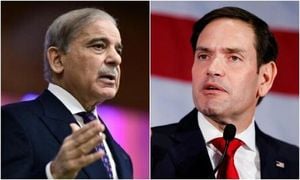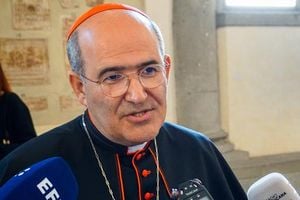On May 1, 2025, hundreds of people participated in a May Day rally at Portland State University in Portland, Oregon. The worker rights protest, organized by 50501 Portland, included a 2.2-mile march through downtown Portland. This year, the May Day demonstrations in Oregon and Washington were particularly significant, as they coincided with widespread protests across the globe, from Paris to Manila, all marking the international day of workers' rights.
Protesters filled the streets in cities like Portland, Olympia, and Seattle, as well as smaller towns such as La Grande and Ellensburg, Washington. Many of these demonstrations were aimed at addressing the ongoing political unrest and the policies of the Trump administration, especially regarding immigration and labor rights.
In Salem, Oregon's state capitol, hundreds gathered in solidarity for May Day. Reyna Lopez, the executive director of Pineros y Campesinos Unidos del Noroeste (PCUN), a prominent farmworker advocacy group, articulated the urgency of the situation. "There have been many attacks on our immigrant community from executive orders to ICE being able to now have free rein," she said. Her organization, along with several religious groups, filed a lawsuit against the Trump administration just days prior, seeking to block immigration enforcement at sensitive locations like schools and hospitals.
Lopez emphasized the importance of immigrants in Oregon, stating, "Immigrant Oregonians are home. They are what makes the state beautiful and prosperous. They’re our friends, our neighbors, they’re farmworkers, they’re grocery workers, they’re people that make the state work." This sentiment resonated with many at the rally, highlighting the vital role of immigrants in the local economy and community.
At the Portland State University rally, Margaret Hess, a passionate activist, rang a large bell engraved with the word "shame." She expressed her commitment to the cause, saying, "I am at every single one I can go to. We are fighting for our lives here. I don’t plan on sitting this one out." Hess, who traveled from Vancouver, Washington, underscored the emotional stakes of the protests, drawing attention to the personal stories behind the political issues.
Julia Marie, another participant, noted a different atmosphere at this year's May Day events compared to previous years. "I feel like the energy has been positive. I haven’t seen major agitators. It just feels like people show up and they just want to march," she said. This year, police presence was notably different, with officers in white shirts engaging with protesters and helping to direct traffic, aiming to maintain order without escalating tensions.
In Seattle, demonstrators packed Cal Anderson Park, echoing similar sentiments as those in Portland. Activists rallied against the Trump administration's immigration policies, calling for the abolition of Immigration and Customs Enforcement (ICE) and an end to mass deportations. They also demanded the closure of the Northwest Detention Center in Tacoma, Washington, a facility that houses undocumented immigrants awaiting deportation.
The May Day protests extended beyond the Pacific Northwest, with significant gatherings reported in cities around the world. In Paris, France, demonstrators took to the streets, condemning various policies emanating from Washington, D.C. Protesters in Istanbul, Turkey, and Belgrade, Serbia, also voiced their concerns, emphasizing labor rights and the need for government accountability. The international scope of these protests highlighted a shared frustration with political leadership and economic inequality.
In the Philippines, activists gathered to commemorate the day, while in Jakarta, Indonesia, crowds called for better labor conditions and workers' rights. Similarly, protests in Seoul, South Korea, and Dakar, Senegal, reflected a global movement advocating for the rights of workers and marginalized communities.
As May Day continues to serve as a platform for expressing solidarity among workers worldwide, the events of 2025 demonstrate a heightened urgency in addressing issues of immigration and labor rights, particularly in the context of the Trump administration's policies. Activists across the globe are not only commemorating the historical significance of the day but are also actively engaging in a struggle for a more equitable future.
In conclusion, the May Day protests of 2025 stand as a testament to the ongoing fight for workers' rights and the protection of immigrant communities. As activists rally together, their voices echo across borders, calling for justice and equality in a world that often overlooks the contributions of the most vulnerable.




